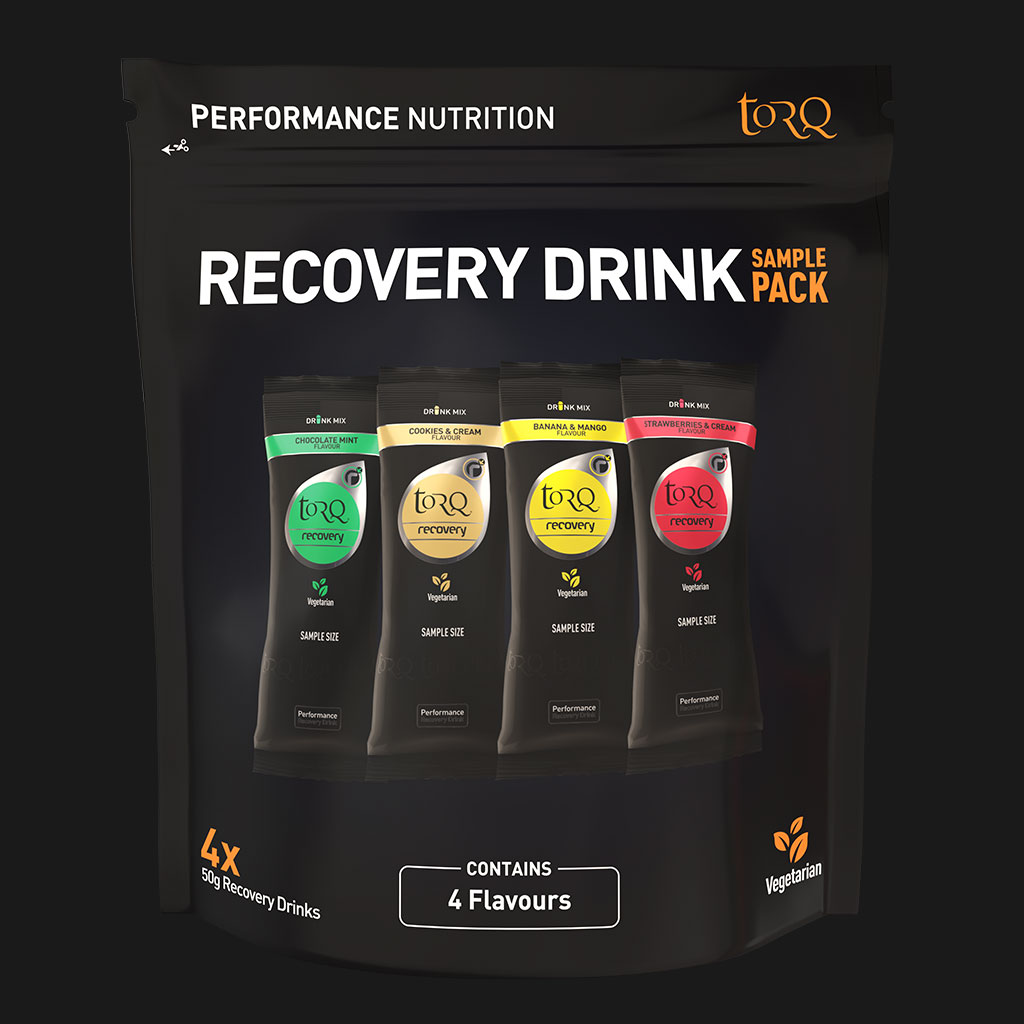TORQ 4 Recovery Drink Sample Pack
This special sample pack provides you with 1 of each flavour of TORQ Recovery Drink
1 x Banana & Mango
1 x Chocolate Mint
1 x Cookies & Cream
1 x Strawberries & Cream
£9.95
Product Highlights
- 3:1 Carbohydrate:Protein
- High Quality Whey Protein
- Multiple Transportable Carbohydrates
- Glutamine for Muscle/Immune Protection
- Ribose for Cellular Regeneration
- Part of the TORQ Recovery SystemTM
- Simply add to Water
Product Summary
TORQ Recovery Drink is a highly advanced post-exercise nutritional drink formulation that has been designed to Rehydrate, Refuel, Repair and Recharge your fatigued physiology after heavy exercise. We call these the 4 R’s:
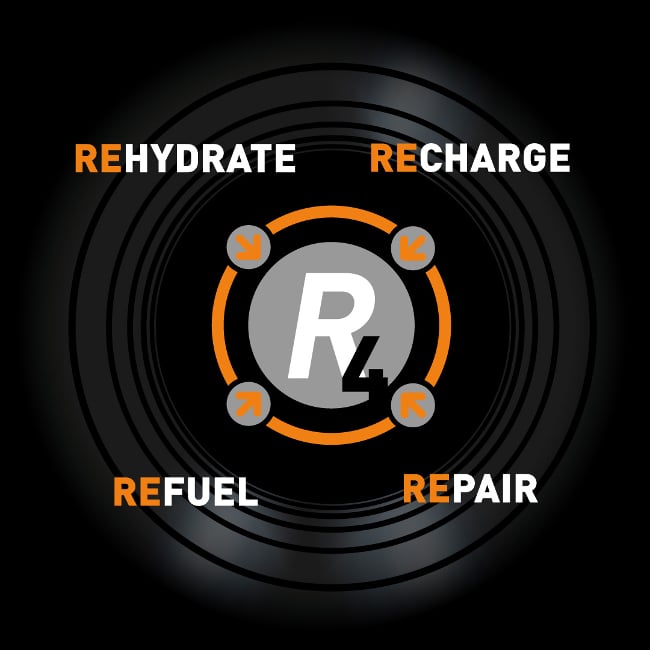
TORQ Recovery Drink has been designed to work as part of the highly comprehensive and thorough TORQ Recovery System. This system considers the level of activity you are performing and recommends concepts and products from the TORQ range to suit your physical loading in a cumulative fashion. For further information on the TORQ Recovery System, click here.
TORQ Recovery Drink powder is mixed with water to form a very smooth luxurious shake – the fluid content addressing the first of the 4 R’s, ‘hydration’. Our unique matrix of Glucose Polymers, Fructose (Multiple-Transportable Carbohydrates) and Whey Protein Isolate stimulate the rapid absorption of carbohydrate to re-stock vital glycogen stores. Along with our use of high quality Whey Proteins, our active ingredients, D-Ribose, L-Glutamine and blend of carefully selected vitamins and minerals work together to repair and recharge over-stressed muscle fibres. D-Ribose in particular is unique to the TORQ brand and there is no other nutrient available on the market today that is capable of refreshing energy levels at the intra-cellular level. We consider TORQ recovery to be the most thorough and effective formulation of its kind on the market today – yet we flavour it NATURALLY and use no colours or artificial sweeteners. There is not a single ingredient within TORQ recovery’s formulation that isn’t derived from a natural source, or doesn’t naturally-occur within the human body.
TORQ recovery represents this 3:1 blend of Multiple Transportable Carbohydrates and high quality Whey Protein. Research suggests that consuming Multiple-Transportable Carbohydrates and Whey Protein at a 3:1 ratio together immediately after exercise will speed up glycogen synthesis. In other words, the multi-consumption of Whey Protein, Glucose-Derivatives and Fructose-Derivatives will help you to store carbohydrate more effectively than any other method. Research has also proven that Whey Protein is faster acting, more soluble and absorbed/synthesised more readily than any other kind of protein, thus it provides the amino acids necessary for muscle repair with little delay.
Consuming TORQ Recovery within 15 minutes of exercise completion to take advantage of the ‘glycogen storage window of opportunity’ is also essential. This is called the ‘non-insulin phase’ of carbohydrate absorption.
Our 5-minute video below talks about the recovery process and how this product fits into an overall strategy, so please take the time to watch it:

Product Usage
The table below indicates how the recommended dose of TORQ Recovery varies depending on how heavy you consider your workout to be. The harder and more draining the workout, the more TORQ Recovery Drink powder you will need.
| Exercise Load | Level Scoops | Powder Dose | Amount of Water |
|---|---|---|---|
| Light Exercise | 0 scoops | 0g | 0ml |
| Moderate Exercise | 2 scoops | 50g | 200ml |
| Hard Exercise | 3 scoops | 75g | 300ml |
| Heavy Exercise | 4 scoops | 100g | 400ml |
There is clear justification for taking a smaller dose of TORQ Recovery for lighter-moderate intensity exercise sessions to ‘assist’ in the recovery process – not every session necessarily requires the highest dose. That said, ensure that you take the optimal dose (4 scoops) where necessary – after exhaustive high volume or high intensity workouts (Heavy Exercise). 4 scoops will provide the research-supported 20-25g dose of high quality protein as well as just under 70g of multiple-transportable carbohydrates, which can be further supplemented with additional regular carbohydrate feeds post workout. Refer to the TORQ Recovery System for details.
You should consider getting yourself a TORQ Mixer Bottle, but as TORQ Recovery mixes very easily, as long as you have a receptacle with a watertight lid and some air space for mixing, that should work well too. Always add the level scoops of powder to the appropriate amount of water, not the other way round, and shake well to mix. Chilled water is ideal and adding crushed ice is even better! Once mixed, treat as fresh milk, keep refrigerated and consume within 24 hours.
Technical Information
In this section we cover the benefits, properties and ingredients used within this product in detail…
Hydration: It goes without saying that rehydration is an important part of the recovery process and the water you mix with the powder to make your drink will clearly help with this process. In situations where fluid losses are particularly high, your TORQ Recovery Drink will not provide sufficient fluid for comprehensive rehydration, so you should continue to drink plenty of fluids after your recovery drink has been consumed. Remember that comprehensive rehydration in exceptional circumstances also requires the replacement of lost electrolytes to restore homeostatic balance, so you may also wish to consider consuming TORQ Hydration to further assist the fluid replacement process when necessary.

Refuelling/Replenishing Carbohydrate Stores: The body holds a very limited amount of stored (endogenous) carbohydrate in the muscles and liver – and this stored endogenous carbohydrate is called ‘glycogen.’ In total these stores equate to around 5% of the body’s total energy stores, however carbohydrate is the preferred fuel source and during exercise can equate to over 50% (or more) of total energy expended, depending on the intensity and duration of the exercise. These limited stores combined with a limited capacity to absorb and use carbohydrate during exercise can result in them becoming almost completely depleted during an intense endurance training session or competition.
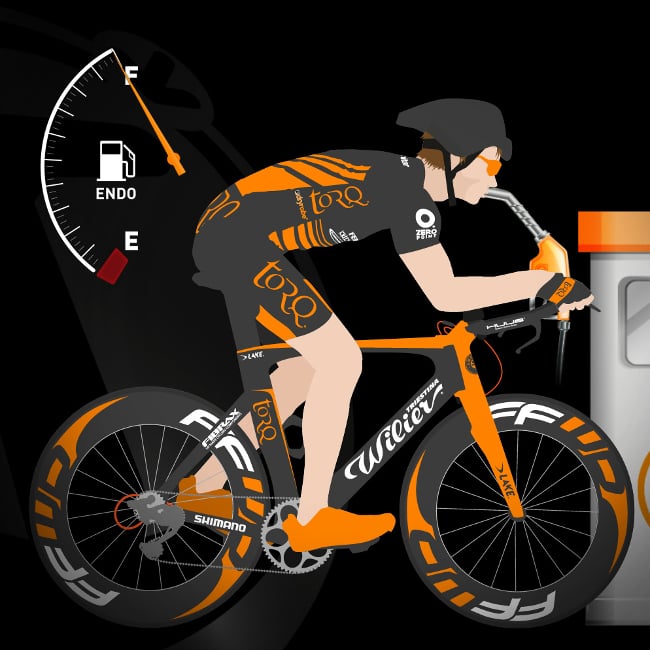
Once depleted, the body can replenish these glycogen stores in around 24hours to full resting levels, provided sufficient carbohydrate is taken in, however this process can take much longer if inadequate carbohydrate is consumed. Due to the time it takes for the body to restock these stores during heavy bouts of training and competition, where sessions are completed with limited rest and recovery, getting sufficient fuel on board and stored as glycogen becomes critical to performance in subsequent sessions and has been shown through research to restore exercise capacity more rapidly.
Post exercise, there are two main phases to replenishing carbohydrate stores. Initially there is a very rapid phase which occurs independently of the hormone insulin and lasts around 30-60 minutes and this is followed by a much slower insulin-dependent phase which can last several hours. During this initial phase, the body is able to rapidly convert carbohydrate into glycogen thanks to the activity of the exercise-dependent Glut-4 transporter which works in a similar way to insulin. This, in combination with an increased exercise-induced insulin sensitivity, aiding the storage process further, makes it absolutely vital that the correct calories are consumed within the brief post-exercise window. Delaying carbohydrate intake by 2 hours or more has been shown to reduce the rate of carbohydrate storage (re-synthesis) by 50% which is not advisable with another competition or hard training session looming. It is therefore important to make best use of this immediately after exercise by ensuring adequate carbohydrate and this is why we recommend that TORQ Recovery is consumed within 15 minutes of finishing exercise.
So there is a well established need for carbohydrate post exercise, but how much is required and in what form? Due to the limited timeframe in which the body is able to rapidly store carbohydrate after exercise, it pays to make maximum use of this time and get carbohydrate into the body as quickly as possible. The most effective way to do this is by ingesting some fast absorbing high GI (Glycaemic Index) forms of carbohydrate to ensure that it is delivered into the system quickly. High GI carbohydrates not only cause a rapid rise in blood sugar by delivering carbohydrate quickly, but also after the initial ‘insulin independent’ stage of recovery, it provokes a rapid release of insulin (the hormone responsible for the storage of carbohydrate) which further aids in the replenishment of the body’s endogenous stores of carbohydrate. As discussed below, fructose, which although a low GI carbohydrate, also plays a part because of its unique delivery method however.
The Role of Multiple-Transportable Carbohydrates: The speed of carbohydrate absorption can also be further enhanced through the use of multiple transportable carbohydrates (i.e. two forms of carbohydrate that don’t compete for absorption in the gut) such as Maltodextrin:Fructose (as used in TORQ Recovery). Research by Wallis et al. has shown that the use of Glucose and Fructose combined can give glycogen re-synthesis rates comparable to some of the highest reported in research. Further to this Decombaz et al. recently demonstrated that using Maltodextrin and Fructose post exercise resulted in a two fold increase in the rate of carbohydrate re-synthesis in the liver, one of the major stores of carbohydrate. For short term recovery this has massive implications as a faster re-synthesis rate of carbohydrate will leave you fresher ready for the next training session/competition. The two very short video clips below demonstrate how glucose-derivatives and fructose use different carriers across the gut wall and how combining both allows greater overall carbohydrate absorption. The first clip shows how absorption through the gut wall is limited when carbohydrate is derived from glucose only.
The second clip demonstrates how dual carbohydrate delivery utilising fructose significantly increases absorption.


Muscular Repair & the Role of Whey Protein: Prolonged endurance exercise not only causes a strain on the body’s carbohydrate stores, but also induces muscle damage and causes a breakdown of proteins within the body. The addition of protein to a recovery drink can not only prevent the breakdown occurring, but also increases the rate of post exercise muscle synthesis, having an anabolic effect through offering substrate for muscle repair and aiding training adaptation. Protein synthesis and oxidation rates can be further increased through the use of Whey Isolate (the protein used in TORQ Recovery), a soluble protein that has a fast intestinal absorption further speeding up the rate of recovery. Significantly also, the addition of whey protein to a carbohydrate recovery drink has also been shown to elevate the circulating insulin concentrations and aid the storage of carbohydrate in the muscle and liver further, with a comparatively lower dose of carbohydrate.
An amalgamation of literature over the past decade has highlighted the importance of nutrition on adaptations to exercise training, with key considerations surrounding type, timing and quantity of protein and carbohydrate ingestion. Protein is essential for roles such as functional (cellular adaption) and structural (muscle fibre) repair post exercise. Furthermore, the role of protein regulates the activity of enzymes, improving the efficiency of cells that allow us to produce energy powering exercise. Research has concluded that when protein and carbohydrate are co-ingested immediately post exercise, the replenishment of stored muscle glycogen content is quicker compared to high carbohydrate alone. Furthermore, the rate of replenishment remains higher for a longer period of time. This finding proposes positive implications for athletes that compete across a multi-stage events where the window for glycogen replenishment post exercise is narrow.
Whey protein is rich in amino-acids, which are responsible for the up-regulation of muscle protein synthesis following exercise. Whey protein contains a rich source of the essential amino acid leucine, which stimulates protein synthesis better than any other protein source. Couple this with whey protein’s exceptional solubility, bioavailability and fast-acting properties, from a performance perspective, it should always be the first choice.
If you’re interested in learning more about protein, recovery and the performance benefits of regular daily protein intake, please take the time to read our Protein, Performance and 20-25g Protein Recipes article.
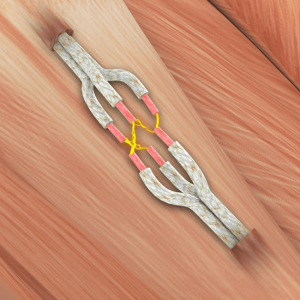
TORQ Recovery’s Unique Micronutrients: It is TORQ’s unique use of D-Ribose and L-Glutamine that sets it apart from other recovery products on the market. L-Glutamine helps to protect the muscles from catabolic (muscle degrading) processes after exercise and also strengthens the immune system. D-Ribose re-charges the muscle cells after exercise so that they have the energy to contract to their full potential within 24 hours, a process that would take up to 3 days without supplemental Ribose. These are particularly expensive ingredients and it is not unusual for nutrition companies to either avoid using these expensive ingredients altogether or claim that their products contain important components like these, whilst providing too small a dose to have a significant effect. We do not believe in compromise, so every serving of TORQ Recovery contains a dose of D-Ribose and L-Glutamine that has been verified by the available research (see references).
Further Information on L-Glutamine: Glutamine is the most abundant amino acid in the body, in a large part because it is needed a lot by the brain, intestines, kidneys, lungs and immune system and also because you can manufacture your own. It is actually termed a ‘non-essential amino acid’, but this can be misleading, because under times of high physiological stress, if you leave your body to produce its own supply, it will break down muscle tissue in order to make it available.

Logic dictates that this is not desirable when you are a training athlete. Therefore, supplementation with L-Glutamine immediately after exercise stops the body scavenging for an alternative supply and eating into your well-earned muscle. It also ensures that plenty of L-Glutamine is available to fuel the immune system. Numerous studies have considered the effects of L-Glutamine supplementation on immune function and although the findings are mixed, there appears to be enough evidence to support its worth (18,20). TORQ Vegan recovery contains the full research-recommended dose (6 grams) of L-Glutamine. Further information about L-Glutamine can be found HERE.
Further Information on D-Ribose: Ribose is present within every living cell of the body and is used to manufacture ATP (the energy currency of the cell) from scratch. Whilst the body can manufacture its own ribose from glucose, this requires energy and is a very slow process. Research into ribose supplementation (17,18) has proven that taking as little as 3-5grams per day will return cellular levels of ATP to normal within 6-22 hours of exhaustive exercise. Without supplementation, this is likely to take between 26 and 93 hours (this represents a 340-430% improvement in cellular recovery when supplementing with ribose).
Every cell in your body contains ATP (adinosine triphosphate), an energy-rich compound that provides virtually all the energy needed to function on a second-by-second basis. When ATP is broken down into ADP + Pi (adinosine diphosphate + inorganic phosphate) energy is released and this is used to power all our bodily functions. Naturally then, it is the breakdown of ATP within the cells of the working muscles that provides the energy for exercise. Without it you wouldn’t be going anywhere!

It is through the metabolism of carbohydrate, fat and protein that ADP + Pi is reformed to make ATP. This ATP is then available to be used for muscular contraction. As the muscle uses it, once again it will break down to ADP + Pi and so it goes on. When exercising, this cycle rapidly and continually takes place in order to satisfy the substantial turnover of energy required.
Research has shown that after maximal high load exercise, the pools of ATP and ADP + Pi in skeletal muscle cells are reduced by as much as 20-28 percent. The mechanisms behind this are rather complex and involve the loss of a compound called AMP (adinosine monophosphate), however, the net effect is that the overall pools of ATP and ADP + Pi within each cell is reduced, which seriously limits their energy potential. It doesn’t matter how much carbohydrate you ram into your body, if these nucleotide levels are low, you’re not going to have the raw materials available to produce power effectively. To further compound the problem, once AMP has left the cell, there’s no getting it back and so ATP and ADP + Pi levels will remain low, perhaps sinking further if another high intensity bout of exercise is experienced.
It’s worth noting that most of the studies in the Sports Science arena have tested D-Ribose supplementation in relation to improvements in muscular power and they have drawn a blank. This is correct and there’s no evidence that D-Ribose will make you stronger. Its effects on cellular recovery (returning strength levels to normal after heavy exercise) however cannot be denied – it’s a physiological fact and it’s the inclusion of this amazing nutrient into TORQ Recovery Drink’s formulation that provides it with a very unique and valuable edge. TORQ Recovery Drink contains the full research-recommended dose of D-Ribose (3-5 grams depending on body size). 3% of TORQ Recovery’s ingredient matrix is D-Ribose. For further information on D-Ribose, click HERE.
Continued Carbohydrate Consumption: In order to ensure maximum re-synthesis (storage) rates, research has pointed towards consuming around 1-1.2grams per kg body weight immediately after exercise. Anymore is unlikely to offer any further benefit and any less and it will potentially compromise the effectiveness of your recovery. This initial feed should then be followed up with regular carbohydrate feeding in frequent doses afterwards. There are a variety of regular low fat, high carbohydrate food choices that will enable you to achieve the desired amount of carbohydrate, but we do have a few products in our portfolio that will give you a helping hand. Use these products for pure convenience, or in situations where your exercise load is particularly high and you need specific tools to assist with the recovery process.

TORQ Organic Energy represents an easy way of increasing the carbohydrate content of food. This product is available separately and forms part of the TORQ Recovery System. TORQ Energy Organic, often dubbed ‘the invisible calorie’ is compact/concentrated in nature and has no flavour, so can be added to any kind of food to boost the carbohydrate content. Adding it to a glass of fruit juice for instance, or a cup of soup? Click HERE for further information.
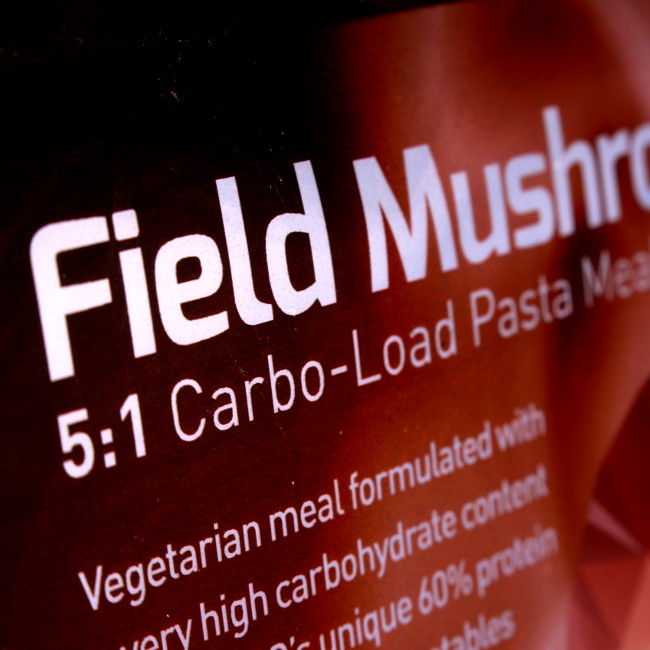
TORQ also offer a range of Meals and Breakfasts which have been designed specifically with the training athlete in mind. Available with different nutritional profiles, depending on the amount of carbohydrate you need, these meals and breakfasts can be used to supplement your diet to ensure you’re getting the vital nutrients you need to recover properly. Click HERE to view our full SNAQ range.

Therefore, after consuming your recovery drink, aim to consume between 1-1.2grams of carbohydrate per hour for 3-4 hours. Research has also shown frequent (every 15-30minutes) provision of carbohydrate after exercise further stimulates the re-synthesis of the body’s stores of carbohydrate better than at longer intervals, so little and often will help aid the recovery process.
Gluten Free Formulation: TORQ Recovery Drink is a gluten-free product.
Natural Flavours and No Colours: Under exercise stress, digestion is affected as blood is diverted to the working muscles and any solutes added to a product will raise its osmolality unnecessarily making it harder to digest, so irrespective of the health debate surrounding the consumption of artificial ingredients, during and immediately after exercise is certainly not the time to take them. Therefore, we only use natural flavours that the body can recognise and break down easily and we don’t use colours (artificial or natural), because they simply don’t need to be in the product.
No Artificial Sweeteners: For the same reasons as highlighted above, we don’t believe in the use of artificial sweeteners like Aspatame, Acsulfame-K, Saccharine and Sucralose. These artificial sweeteners are 100’s of times sweeter than sugar and Aspartame/Acsulfame-K are particularly controversial with regard to long-term health. They offer no performance benefit at all and our stance is the same with these as with colours and preservatives – if they don’t need to be included in our formulations for functional reasons, why include them?
Immune Support
The research is clear, fuelling with carbohydrate and ensuring that you consume a recovery drink immediately after exercise will not only boost performance and assist in the overall recovery process, but it will also support your immune system, leaving you less vulnerable to infection.
According to research by Gleeson and Bishop (2000) carbohydrate becomes an important fuel for the immune system cells which can increase tenfold during and post exercise when compared with resting conditions. These immune system cells are boosted by the body to help immunity at this vulnerable time and Carbohydrate supports their effectiveness. Also, according to Cupps and Fauci (1982) cortisol, a stress hormone that is linked to immunosuppression, is inhibited by the presence of Carbohydrate.
Ed Burke (2002) dedicates 2 pages of his book ‘Serious Cycling’ to the role that fuelling with carbohydrate during exercise plays in strengthening the immune system. Talking of researcher Dr Nieman, he says:
“Our research shows that sports drinks not only provide carbohydrate energy during exercise, but support the link between sports drinks and less stress on the immune system. Carbohydrate drinks of about 6 to 10% carbohydrate (TORQ Energy Drink is within this range) will not eliminate the stress of cycling, but our research and work of others show they can reduce the increase of several by-products of stress and hard exercise.”
In cooler conditions, when drinking an energy drink is less desirable, as our Fuelling System suggests, carbohydrate can be delivered in more appropriate concentrated forms like our Energy Gels, Energy Bars and Energy Chews.
All of this points to ensuring that you maintain good fuelling practices and that you feed immediately with Carbohydrate immediately after exercise. TORQ Recovery Drink provides this carbohydrate, along with a potent dose of Glutamine, which has also been found to assist and support the immune system following exercise.
The role of Glutamine is an interesting one and again Gleeson and Bishop discuss this. Glutamine is a non-essential amino acid, meaning that the human body can produce it on demand without having to source it from the diet and therefore it will remain at consistent baseline concentrations to support normal immune function. During the stress of higher load exercise however, the demand for glutamine utilisation may exceed the body’s production capabilities. Blood glutamine concentrations can be decreased by up to 20% below baseline following prolonged or strenuous exercise and will normally take around 24 hours to recover fully – and can take even longer if training loads are exceptionally high. Also, these percentage reductions can further increase if athletes experience exceptionally high training loads. This has lead some researchers to re-label Glutamine as ‘conditionally-essential’ rather than ‘non-essential’ because there are times when supplementation is beneficial and one of these occasions is post exercise.
Again, Cupps and Fauci (1982) assert that Glutamine availability is suppressed in the absence of Carbohydrate – in other words, Carbohydrate consumption during exercise increases Glutamine availability. Paradoxically therefore, the more diligently you fuel with Carbohydrate and pay attention to your recovery nutrition, the less important Glutamine supplementation becomes, because the presence of Carbohydrate reduces the drain on Glutamine reserves. That said, the term ‘heavy exercise’ is quite broad and even with the most diligent of fuelling practices some training sessions have the potential to leave you exceptionally drained. To this end, our TORQ Recovery Drink doesn’t only contain a substantial serving of fast-delivery carbohydrate, but also a research-recommended dose of Glutamine. We call it ‘belt and braces’.
If you are interested in learning more, we have created the definitive guide to help you understand what your immune system is, how it works, how to strengthen it and how to fight infection effectively should your immune defences be breached. Click HERE for further information. Also, as a direct result of producing these resources, we have since developed 2 specific Immune System Support products:
Our TORQ dFND product has been developed from a need to offer our customers a simple one-a-day tablet solution to deliver high-potency Vitamin D and Zinc to support the healthy daily functioning of the immune system. For further details or to purchase TORQ dFND, click HERE.
Our TORQ aTAC product provides research-recommended doses of Vitamin C, Glutamine and Echinacea through a mega-dosing protocol inspired by the studies we have referred to within these resources. TORQ aTAC is to be taken at the first signs of cold or flu to reduce the symptoms and severity of illness. For further details or to purchase TORQ aTAC, click HERE.
Nutritional Information
Nutritional Information for all flavours of TORQ Recovery Drink are supplied under this tab.
Banana & Mango
Ingredients: Skimmed Milk Powder (Milk), Maltodextrin (Glucose Polymers 28%), Fructose (20%), L-Glutamine (6%), Whey Protein Isolate (Milk) (4%), D-Ribose (3%), Thickener (Tara Gum), Natural Flavours (1%), Vitamin & Mineral Mix (0.1%)
| per 100g serving | per 75g serving | per 50g serving | |
|---|---|---|---|
| Energy(kJ) | 1453 | 1090 | 727 |
| Energy(Kcal) | 342 | 257 | 171 |
| Fat(g) | 0.2 | 0.2 | 0.1 |
| of which saturates(g) | 0.1 | 0.1 | 0.1 |
| Carbohydrates(g) | 67 | 50 | 33 |
| of which sugars(g) | 41 | 31 | 21 |
| Fibre (g) | 2.0 | 1.5 | 1.0 |
| Protein (g) | 17 | 13 | 8.6 |
| Total Protein (g)* | 23 | 17.3 | 11.5 |
| Salt (g) | 0 | 0 | 0 |
| Sodium (g) | 0.1 | 0.15 | 0.2 |
| D-Ribose (g) | 3.0 | 2.3 | 1.5 |
| L-Glutamine (g) | 6.0 | 4.5 | 3.0 |
| Zinc (mg) | 1.9 | 1.4 | 0.1 |
| Iron (mg) | 1.9 | 1.4 | 1.0 |
| Niacin (mg) | 1.6 | 1.2 | 0.8 |
| Vitamin E (mg) | 1.0 | 0.8 | 0.5 |
| Pantothenic Acid (mg) | 0.6 | 0.5 | 0.3 |
| Vitamin B6 (mg) | 0.3 | 0.2 | 0.2 |
| Riboflavin (mg) | 0.2 | 0.2 | 0.1 |
| Thiamine (mg) | 0.2 | 0.2 | 0.1 |
| Vitamin A (mcg) | 100 | 75 | 50 |
| Folacin (mcg) | 25 | 18.7 | 13 |
| Biotin (mcg) | 19 | 14.2 | 9.5 |
| Vitamin D (mg) | 0.4 | 0.3 | 0.2 |
| Vitamin B12 (mg) | 0.2 | 0.2 | 0.1 |
| per 100g serving | per 75g serving | per 50g serving | |
|---|---|---|---|
| Total BCAA (g) | 3.8 | 6.3 | 1.9 |
| Leucine (g) | 1.6 | 1.2 | 0.8 |
*The Total Protein figure indicates the sum of protein + glutamine, which is representative of the overall protein content of this product.
Allergy Information: For allergens, see ingredients in bold. Contains Milk. No gluten containing ingredients used.
No Preservatives // No Colours // No Artificial Sweeteners // Suitable for Vegetarians // Wheat Free
Tested under ISO 17025 for the presence of prohibited substances
Chocolate Mint
Ingredients: Skimmed Milk Powder (Milk), Maltodextrin (Glucose Polymers 28%), Fructose (20%), L-Glutamine (6%), Cocoa Powder, Whey Protein Isolate (Milk) (4%), D-Ribose (3%), Thickener (Tara Gum), Natural Flavours (2%), Vitamin & Mineral Mix (0.1%)
| per 100g serving | per 75g serving | per 50g serving | |
|---|---|---|---|
| Energy(kJ) | 1439 | 1079 | 720 |
| Energy(Kcal) | 339 | 254 | 170 |
| Fat(g) | 0.8 | 0.4 | 0.6 |
| of which saturates(g) | 0.5 | 0.4 | 0.3 |
| Carbohydrates(g) | 65 | 48 | 32 |
| of which sugars(g) | 38 | 28 | 19 |
| Fibre (g) | 3.9 | 2.9 | 2.0 |
| Protein (g) | 17 | 12 | 8.3 |
| Total Protein (g)* | 23 | 17.2 | 11.5 |
| Salt (g) | 0 | 0 | 0 |
| Sodium (g) | 0.1 | 0.15 | 0.2 |
| D-Ribose (g) | 3.0 | 2.3 | 1.5 |
| L-Glutamine (g) | 6.0 | 4.5 | 3.0 |
| Zinc (mg) | 1.9 | 1.4 | 0.1 |
| Iron (mg) | 1.9 | 1.4 | 1.0 |
| Niacin (mg) | 1.6 | 1.2 | 0.8 |
| Vitamin E (mg) | 1.0 | 0.8 | 0.5 |
| Pantothenic Acid (mg) | 0.6 | 0.5 | 0.3 |
| Vitamin B6 (mg) | 0.3 | 0.2 | 0.2 |
| Riboflavin (mg) | 0.2 | 0.2 | 0.1 |
| Thiamine (mg) | 0.2 | 0.2 | 0.1 |
| Vitamin A (mcg) | 100 | 75 | 50 |
| Folacin (mcg) | 25 | 18.7 | 13 |
| Biotin (mcg) | 19 | 14.2 | 9.5 |
| Vitamin D (mg) | 0.4 | 0.3 | 0.2 |
| Vitamin B12 (mg) | 0.2 | 0.2 | 0.1 |
| per 100g serving | per 75g serving | per 50g serving | |
|---|---|---|---|
| Total BCAA (g) | 3.8 | 6.3 | 1.9 |
| Leucine (g) | 1.6 | 1.2 | 0.8 |
*The Total Protein figure indicates the sum of protein + glutamine, which is representative of the overall protein content of this product.
Allergy Information: For allergens, see ingredients in bold. Contains Milk. No gluten containing ingredients used.
No Preservatives // No Colours // No Artificial Sweeteners // Suitable for Vegetarians // Wheat Free
Tested under ISO 17025 for the presence of prohibited substances
Cookies & Cream
Ingredients: Skimmed Milk Powder (Milk), Maltodextrin (Glucose Polymers 28%), Fructose (19%), L-Glutamine (6%), Whey Protein Isolate (Milk) (4%), D-Ribose (3%), Thickener (Tara Gum), Natural Flavours (1%), Vitamin & Mineral Mix (0.1%)
| per 100g serving | per 75g serving | per 50g serving | |
|---|---|---|---|
| Energy(kJ) | 1461 | 1096 | 731 |
| Energy(Kcal) | 344 | 258 | 172 |
| Fat(g) | 0.2 | 0.2 | 0.1 |
| of which saturates(g) | 0.2 | 0.15 | 0.1 |
| Carbohydrates(g) | 67 | 50 | 34 |
| of which sugars(g) | 41 | 31 | 21 |
| Fibre (g) | 2.0 | 1.5 | 1.0 |
| Protein (g) | 17 | 13 | 8.6 |
| Total Protein (g)* | 23 | 17.2 | 11.5 |
| Salt (g) | 0 | 0 | 0 |
| Sodium (g) | 0.1 | 0.15 | 0.2 |
| D-Ribose (g) | 3.0 | 2.3 | 1.5 |
| L-Glutamine (g) | 6.0 | 4.5 | 3.0 |
| Zinc (mg) | 1.9 | 1.4 | 0.1 |
| Iron (mg) | 1.9 | 1.4 | 1.0 |
| Niacin (mg) | 1.6 | 1.2 | 0.8 |
| Vitamin E (mg) | 1.0 | 0.8 | 0.5 |
| Pantothenic Acid (mg) | 0.6 | 0.5 | 0.3 |
| Vitamin B6 (mg) | 0.3 | 0.2 | 0.2 |
| Riboflavin (mg) | 0.2 | 0.2 | 0.1 |
| Thiamine (mg) | 0.2 | 0.2 | 0.1 |
| Vitamin A (mcg) | 100 | 75 | 50 |
| Folacin (mcg) | 25 | 18.7 | 13 |
| Biotin (mcg) | 19 | 14.2 | 9.5 |
| Vitamin D (mg) | 0.4 | 0.3 | 0.2 |
| Vitamin B12 (mg) | 0.2 | 0.2 | 0.1 |
| per 100g serving | per 75g serving | per 50g serving | |
|---|---|---|---|
| Total BCAA (g) | 3.8 | 6.3 | 1.9 |
| Leucine (g) | 1.6 | 1.2 | 0.8 |
*The Total Protein figure indicates the sum of protein + glutamine, which is representative of the overall protein content of this product.
Allergy Information: For allergens, see ingredients in bold. Contains Milk. No gluten containing ingredients used.
No Preservatives // No Colours // No Artificial Sweeteners // Suitable for Vegetarians // Wheat Free
Tested under ISO 17025 for the presence of prohibited substances
Strawberries & Cream
Ingredients: Skimmed Milk Powder (Milk), Maltodextrin (Glucose Polymers 28%), Fructose (19%), L-Glutamine (6%), Whey Protein Isolate (Milk) (4%), D-Ribose (3%), Thickener (Tara Gum), Natural Flavours (1%), Vitamin & Mineral Mix (0.1%)
| per 100g serving | per 75g serving | per 50g serving | |
|---|---|---|---|
| Energy(kJ) | 1462 | 1097 | 731 |
| Energy(Kcal) | 344 | 258 | 172 |
| Fat(g) | 0.2 | 0.2 | 0.1 |
| of which saturates(g) | 0.2 | 0.1 | 0.1 |
| Carbohydrates(g) | 67 | 51 | 34 |
| of which sugars(g) | 41 | 31 | 21 |
| Fibre (g) | 2.0 | 1.5 | 1.0 |
| Protein (g) | 17 | 13 | 8.6 |
| Total Protein (g)* | 23 | 17.2 | 11.5 |
| Salt (g) | 0 | 0 | 0 |
| Sodium (g) | 0.1 | 0.15 | 0.2 |
| D-Ribose (g) | 3.0 | 2.3 | 1.5 |
| L-Glutamine (g) | 6.0 | 4.5 | 3.0 |
| Zinc (mg) | 1.9 | 1.4 | 0.1 |
| Iron (mg) | 1.9 | 1.4 | 1.0 |
| Niacin (mg) | 1.6 | 1.2 | 0.8 |
| Vitamin E (mg) | 1.0 | 0.8 | 0.5 |
| Pantothenic Acid (mg) | 0.6 | 0.5 | 0.3 |
| Vitamin B6 (mg) | 0.3 | 0.2 | 0.2 |
| Riboflavin (mg) | 0.2 | 0.2 | 0.1 |
| Thiamine (mg) | 0.2 | 0.2 | 0.1 |
| Vitamin A (mcg) | 100 | 75 | 50 |
| Folacin (mcg) | 25 | 18.7 | 13 |
| Biotin (mcg) | 19 | 14.2 | 9.5 |
| Vitamin D (mg) | 0.4 | 0.3 | 0.2 |
| Vitamin B12 (mg) | 0.2 | 0.2 | 0.1 |
| per 100g serving | per 75g serving | per 50g serving | |
|---|---|---|---|
| Total BCAA (g) | 3.8 | 6.3 | 1.9 |
| Leucine (g) | 1.6 | 1.2 | 0.8 |
*The Total Protein figure indicates the sum of protein + glutamine, which is representative of the overall protein content of this product.
Allergy Information: For allergens, see ingredients in bold. Contains Milk. No gluten containing ingredients used.
No Preservatives // No Colours // No Artificial Sweeteners // Suitable for Vegetarians // Wheat Free
Tested under ISO 17025 for the presence of prohibited substances
TORQ Recovery Drink is available for purchase in single serve sample Sachets, Boxes of 10 Sachets, 500g Tubs and 1.5Kg Pouches. We also offer bulk deals on 3Kg and 6Kg:
If you have any questions about this product or any other on this website, please don’t hesitate in contacting us at enquiries@torqfitness.co.uk or on 0344 332 0852.
References
-
- Beelen M, Burke LM, Gibala MJ, Van Loon L JC (2010)
Nutritional strategies to promote post exercise recovery. Int J Sport Nutr Exerc Metab Dec 20(6):515-32. - Burke LM, Collier GR, Beasley SK, Davis PG, Fricker PA, Heeley P and Hargreaves M (1995)
Effect of coigestion of fat and protein with carbohydrate feedings on muscle glycogen storage. Journal Applied Physiology, 76(6) 2187-2192. - Fallowfield JL, Williams C, Singh R. (1995)
The influence of ingesting a carbohydrate-electrolyte beverage during 4 hours of recovery on subsequent endurance capacity. Int J Sport Nutr 1995; 5: 285-99. - Ivy Jl, Katz AL, Cutler Cl, Sherman WM, Coyle EF (1988)
Muscle glycogen synthesis after exercise: effect of time of carbohydrate ingestion. Journal Applied Physiology. Apr:64(4)1480-5. - Wallis GA, Hulston CJ, Mann CH, Roper HP, Tipton KD, Jeukendrup AE. (2008)
Postexercise muscle glycogen synthesis with combined glucose and fructose ingestion. Med Sci Sports Exerc. Oct;40(10):1789-94. - Décombaz J, Jentjens R, Ith M, Scheurer E, Buehler T, Jeukendrup A, Boesch C. (2011)
Fructose and galactose enhance postexercise human liver glycogen synthesis. Med Sci Sports Exerc. 2011 Oct;43(10):1964-71. - Betts JA, Williams C. (2010)
Short-Term recovery from prolonged exercise. Sports Medicine. 40(11)941-959. - Beelen M, Burke LM, Gibala MJ, Van Loon LJC. (2010)
Nutritional strategies to promote post exercise recovery. Journal of Physical Activity and Health. - Jentjens, R.L., van Loon, L.J., Mann, C.H., Wagenmakers, A.J.,& Jeukendrup, A.E. (2001).
Addition of protein and amino acids to carbohydrates does not enhance postexercise muscle glycogen synthesis. Journal of Applied Physiology), 91(2), 839–846 - van Loon, L.J., Saris, W.H., Kruijshoop, M., & Wagenmakers, A.J. (2000b).
Maximizing postexercise muscle glycogen synthesis: Carbohydrate supplementation and the application of amino acid or protein hydrolysate mixtures. The American Journal of Clinical Nutrition, 72(1), 106–111. - Gibala, M.J. (2007).
Protein metabolism and endurance exercise. Sports Medicine (Auckland, N.Z.), 37(4–5), 337–340. - Howarth, K.R., Moreau, N.A., Phillips, S.M., & Gibala, M.J.(2009).
Coingestion of protein with carbohydrate during recovery from endurance exercise stimulates skeletal muscle protein synthesis in humans. Journal of Applied Physiology (Bethesda, Md.), 106(4), 1394–1402. - Tang, J.E., & Phillips, S.M. (2009).
Maximizing muscle protein anabolism: The role of protein quality. Current Opinion in Clinical Nutrition and Metabolic Care, 12(1), 66–71. - Dangin, M., Guillet, C., Garcia-Rodenas, C., Gachon, P., Bouteloup- Demange, C., Reiffers-Magnani, K., . . . Beaufrère,B. (2003).
The rate of protein digestion affects protein gain differently during aging in humans. The Journal of Physiology, 549(Pt. 2), 635–644. - Zawadzki, K.M.,B.B. Yaspelkis III, and J.L. Ivy. (1992).
Carbohydrate-protein complex increased the rate of muscle glycogen storage after exercise. J Appl Physiol 72:1854-59. - Burke, E.R. PhD (1999).
D-Ribose, what you need to know. Avery Publishing Group. - Burke, E.R. PhD (2002).
Serious Cycling. Human Kinetics. Pages 167-169 (Ribose), 171-172 (L-Glutamine), 173-174 (HMB). - Paswater, R.A. PhD and Fuller, J. PhD (1997).
Building Muscle Mass, Performance And Health With HMB. Keats Publishing. - Williams, M.H. PhD (1998).
The Ergogenics Edge. Human Kinetics. - Wilmore, J.H. and Costill, D.L. (1999).
Physiology of Sport and Exercise. Human Kinetics. - Bompa, T.O. (1999).
Periodization: Theory and Methodology of Training. Human Kinetics. - Baguet A, Reyngoudt H, Pottier A, Everaert I, Callens S, Achten E, Derave W. (2009)
Carnosine loading and washout in human skeletal muscles. J Appl Physiol 106:837–842. - Baguet A, Bourgois J, Vanhee L, Achten E, Derave W (2010a)
Important role of muscle carnosine in rowing performance.J Appl Physiol 109:1096–1101. - Derave W, Ozdemir MS, Harris RC, Pottier A, Reyngoudt H, Koppo K, Wise JA, Achten E (2007)
B-alanine supplementation augments muscle carnosine content and attenuates fatigue during repeated isokinetic contraction bouts in trained sprinters. J Appl Physiol 103:1736–1743. - Harris RC, Tallon MJ, Dunnett M, Boobis LH, Coakley J, Kim HJ, Fallowfield JL, Hill CA, Sale C, Wise JA (2006)
The absorption of orally supplied beta-alanine and its effect on muscle carnosine synthesis in human vastus lateralis. Amino Acids 30:279–289. - Hobson RM, Saunders B, Ball G, Harris RC, Sale C (2012)
Effects of beta alanine supplementation on exercise performance: A Meta Anaylsis. Amino Acids (2012) 43:25–37. - Hills CA, Harris RC, Kim HJ, Harris BD, Sale C, Boobis LH, Kim CK, Wise JA. (2006)
Influence of B-alanine supplementation on skeletal muscle carnosine concentrations and high intensity cycling capacity. Amino Acids 32:225-233. - Van Thienen R, Van Proeyen K, Vanden Eynde B, Puype J, Lefere T, Hespel P. (2009)
Alanine Improves Sprint Performance in Endurance Cycling. Med. Sci. Sports Exerc., Vol. 41, No. 4, pp. 898–903. - Cade R, Conte M, Zauner C, Mars D, Peterson J, Lunne D, Hommen N, Packer D. (1984)
Effects of phosphate loading on 2,3 diphosphoglycerate and maximal oxygen uptake. Med Sci Sports Exerc, 16:263-8. - Kreider RB, Miller GW, Williams MH, Somma CT, Nasser TA. (1990)
Effects of phosphate loading on oxygen uptake, ventilatory anaerobic threshold, and run performance. Med Sci Sports Exerc, 22(2):250-6. - Stewart I, McNaughton L, Davies P, Tristram S. (1990)
Phosphate loading and the effects of VO2max in trained cyclists. Res Quart, 61:80-4. - Kreider RB, Miller GW, Schenck D, Cortes CW, Miriel V, Somma CT, Rowland P, Turner C, Hill D. (1992)
Effects of phosphate loading on metabolic and myocardial responses to maximal and endurance exercise. Int J Sport Nutr 2(1):20-47. - Folland JP, Stern R, Brickley G. (2008)
Sodium phosphate loading improves laboratory cycling time-trial performance in trained cyclists. J Sci Med Sport, 11(5):464-8. - Bernardot, D. PhD (2000)
Nutrition for Serious Athletes. Human Kinetics.
- Beelen M, Burke LM, Gibala MJ, Van Loon L JC (2010)
For research linking immunity to Carbohydrate ingestion during/post exercise and the role of L-Glutamine in immune function:
Gleeson, M. and Bishop, N.C., 2000. Modification of immune responses to exercise by carbohydrate, glutamine and anti‐oxidant supplements. Immunology and Cell Biology, 78(5), pp.554-561.
Cupps, T.R. and Fauci, A.S., 1982. Corticosteroid‐mediated immunoregulation in man. Immunological reviews, 65(1), pp.133-155.
Burke, E.R., 2002. Serious Cycling. Human Kinetics. pp.154-155.
Legault, Z., Bagnall, N. and Kimmerly, D.S., 2015. The Influence of Oral L-Glutamine Supplementation on Muscle Strength Recovery and Soreness Following Unilateral Knee Extension Eccentric Exercise. Int J Sport Nutr Exerc Metab: Oct;25(5):417-26. doi: 10.1123/ijsnem.2014-0209. Epub 2015 Mar 26.
Calder, P.C., Yaqoob, P., 1999. Glutamine and the immune system. Amino Acids: 17(3):227-41.
Ren, W., Li, Y., Yu, X., Luo ,W., Liu, G., Shao, H. and Yin, Y. 2013. Glutamine modifies immune responses of mice infected with porcine circovirus type 2. Br J Nutr: Sep 28;110(6):1053-60. doi: 10.1017/S0007114512006101. Epub 2013 Jan 28.
Gleeson, M. 2008. Dosing and Efficacy of Glutamine Supplementation in Human Exercise and Sport Training. The Journal of Nutrition: Volume 138, Issue 10, pp. 2045S–2049S.
